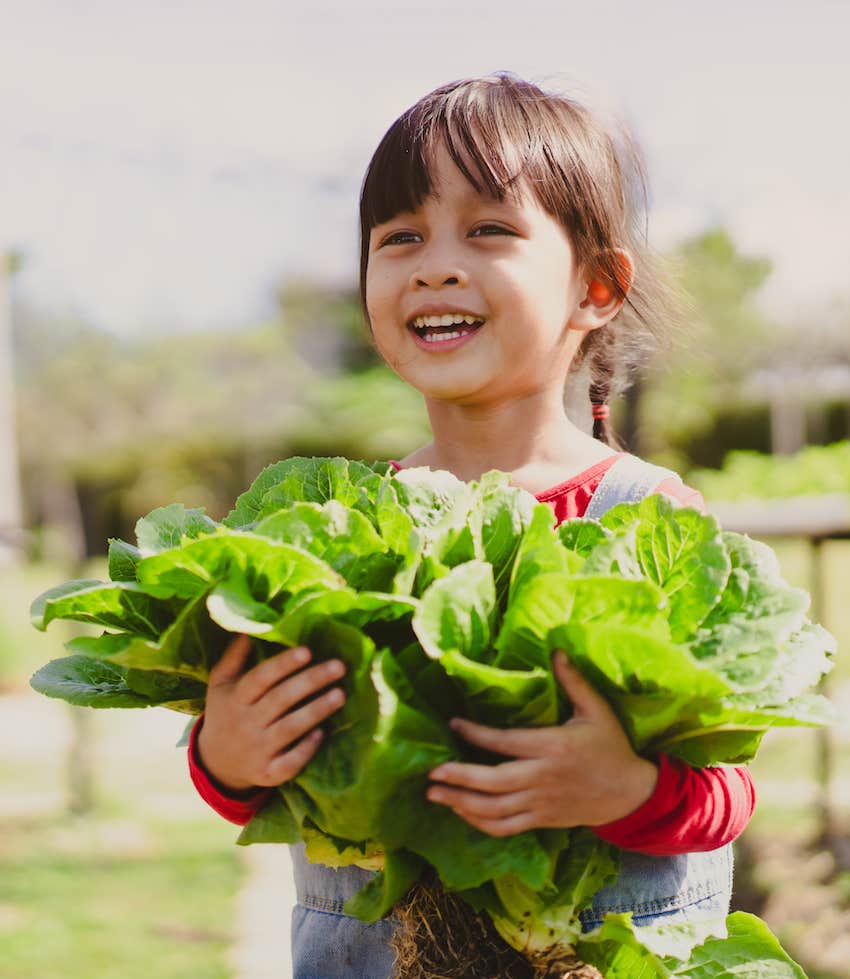10 Ways To Feed Your Kids Healthier Snacks They'll Actually Eat, According To A Nutritionist
Healthy eating habits benefit your children's well-being later in life.
 AnnaNahabed | Canva
AnnaNahabed | Canva Eating a well-balanced diet is always a good choice for anyone, but it's especially important for children. Their organs are still forming, and what they eat becomes their blood, tissue, and cells. Because of this, a nutrient-rich diet — including healthy snacks for kids — is highly recommended.
While it can be difficult to tear your kids away from the Cheez-Its at first, you can gently guide them towards healthy snack options and help them make better dietary decisions on their own — even from a young age.
Doing so not only boosts their well-being now but also teaches them to have a healthier mindset about food from the get-go which will benefit them well into adulthood.
Here are 10 ways to feed your kids healthier snacks they'll eat, according to a nutritionist
1. Choose to give your children whole, organic foods whenever you can.
Some of the best healthy snacks for kids are organic fresh fruits or vegetables. Wash them carefully and cut them up into bite-sized pieces.
Prepare them ahead of time to make your life easier. Cut up half a cup of orange slices, grapes, raisins, pitted dates, celery sticks, or carrot sticks, and portion them out in small snack containers or ziplock baggies. It is so much easier to make smart snacking choices when they are already prepared and ready to go!
 Russamee via Shutterstock
Russamee via Shutterstock
While you're at it, opt for choices with added health benefits. For example, raisins and pitted dates are both good sources of carbohydrates for energy. Dates are an excellent source of potassium, sulfur, iron, and magnesium, and raisins are rich in B vitamins, iron, and potassium. Compounds found in raisins even fight bacteria in the mouth that cause cavities and gum disease!
2. Use smoothies as a nutritious treat.
Smoothies are another easy, delicious way to get intense nutrition — and are fun, healthy snacks for kids to drink, too.
Preparing them with the proper amount of healthy fats, superfoods, and protein will make them nutrient-dense and full of vitamins and minerals. Plus, they're perfect for busy afternoons when you're constantly on the go!
3. Make vegetables more fun by adding tasty-yet-healthy dips.
Hummus is a high-fiber, protein-rich food that is easy and inexpensive to make or buy. (I make mine with a variety of beans.) Hummus goes well with whole-grain, gluten-free crackers, chips, cut-up vegetables (such as red bell peppers or sliced cucumbers), or pita chips.
Avocado or guacamole is another nutrient-dense, healthy dip or sandwich spread you can serve with cut-up veggies, crackers, or chips. It's a great source of potassium, and vitamins K, B, C, and E, and one avocado has around four grams of protein. It's also a great source of mono-unsaturated fat, which provides the body with energy and supports brain function.
4. Add some sea salt to greens for extra flavor and health benefits.
I frequently take raw, freshly-washed green beans or raw okra, and rub or sprinkle unrefined sea salt on them to make a great snack! Green beans have an insulin-type effect on the body, so they make particularly good snacks for anyone who has to be concerned with regulating their blood sugar. Okra is also really delicious eaten raw.
Not only does adding a hint of salt make many veggies taste more delicious, but it also helps the body absorb more nutrients from the food (like potassium) when mineral-rich salt is added. Just be sure to wait until right before you eat them to add salt since adding salt too early can make foods soggy. Always avoid white table salt, use refined salt instead.
5. Be choosy with the oils you use to cook their food.
If you're looking for healthy snacks for your kid, I do not recommend foods made with canola oil (a GMO product) or vegetable oil. This is because most vegetable oils — specifically the ones that don't list the ingredients — contain cottonseed oil.
Cottonseed oil is not food. Yet, it is legal to put cheap oils, like GMO cottonseed oil, into foods. These adulterated vegetable oils include the use of high-risk GMO cottonseed, corn, canola, and soy oil. In fact, in the U.S., over 90 million gallons a year of cottonseed oil are used for human food products, including oils, salad dressings, and margarine.
So be diligent about checking the labels on packaged foods to avoid feeding your child unhealthy oils.
6. Opt for whole-grain crackers and chips.
Some children crave crackers or chips. If this sounds like your kid, I recommend chips and crackers that are made with sprouted, organic seeds, nuts, or grain, and without canola oil or vegetable oil. Avoid options with huge amounts of sugar in them, so you don't have to worry that they're just filling up on empty calories.
7. Avoid added sugars or other less-healthy sweeteners.
Did you know that sugar can shut down your child's immune system? Sugar is an immunosuppressant according to a study published in 2021. That's why it is so important to check the sugar content in your foods and to be aware of what type of sugar foods include.
Always be on the lookout for sugar in processed foods, and try to avoid them. Having natural fructose in fruit is healthy, but added sugars, like high fructose corn syrup or agave (which has more fructose than high fructose corn syrup), are too much for our bodies to handle healthily and can cause all kinds of health-related problems.
For instance, fructose affects the way your body makes insulin, which can contribute to diabetes. Fructose that is added to foods can also make the body create plaque in the arteries, causing heart disease problems, and acts as fuel for cancer cells.
8. Check for additives and artificial ingredients.
Be careful to avoid artificial ingredients and additives like dyes, flavorings, growth hormones antibiotics (given to animals), and toxins from the ocean or environment (as found in fish). They can be toxic to you and your child.
Increasingly since the 1960s, more and more foods incorporate such dyes and additives, including juices, breakfast cereals, salad dressings, and even some fresh produce, according to a study by Purdue University
In light of this research, the executive director of the Center for Science in the Public Interest, Michael F. Jacobson, concluded, "Many children are consuming far more dyes than the amounts shown to cause behavioral problems in some children ... and is a partial reason why behavioral problems have become more common." That's why cutting out these elements can boost your child's health.
9. Know which foods are more likely to have pesticides.
If you are concerned about pesticides or the high cost of organically grown food, you can check out a list of high-pesticide foods. Surprisingly. Some of the most toxic are strawberries, apples, celery, peaches, spinach, imported nectarines and grapes, sweet bell peppers, potatoes, blueberries, lettuce, kale, and collard greens.
 Sukjai Photo via Shutterstock
Sukjai Photo via Shutterstock
On the other hand, the Clean Fifteen list of fruits and vegetables that have the lowest amount of pesticide residue are onions, sweet corn, pineapples, avocados, asparagus, sweet peas, mangoes, eggplant, cantaloupe, kiwi, cabbage, watermelon, sweet potatoes, grapefruit, and mushrooms.
10. Be consistent with your decision to feed them healthy foods.
What we give our children as comforting food, when they are sick or hurt, will be their “comfort food” in the future. They will crave those foods if they are having a tough or emotionally challenging time. It will remind them of the love they felt when you were giving it to them.
So, if you want your child reaching for ice cream or high-sugar cookies when they are older and having an emotionally challenging day (and to avoid obesity, diabetes, or cancer in adulthood), be careful to choose healthy foods for them at all times. They will be grateful to you later in life.
And keep in mind that, as their parent, you are a food role model. They watch what we do and do not eat. And while they may not always listen to us, they will copy what we do, so leading by example is important.
By feeding your kids healthy and nutritious snack options and a variety of fresh, organic whole foods, then that is what their taste buds will adapt to love. Doing so promotes healthy eating habits from a young age that will continue to benefit your children's well-being later in life.
Nancy Addison is a nutritionist, educator, best-selling author, international speaker, healthy chef, and radio show/podcast host. She teaches people about living a healthier, happier life through nutrition and lifestyle.
YourTango may earn an affiliate commission if you buy something through links featured in this article.

